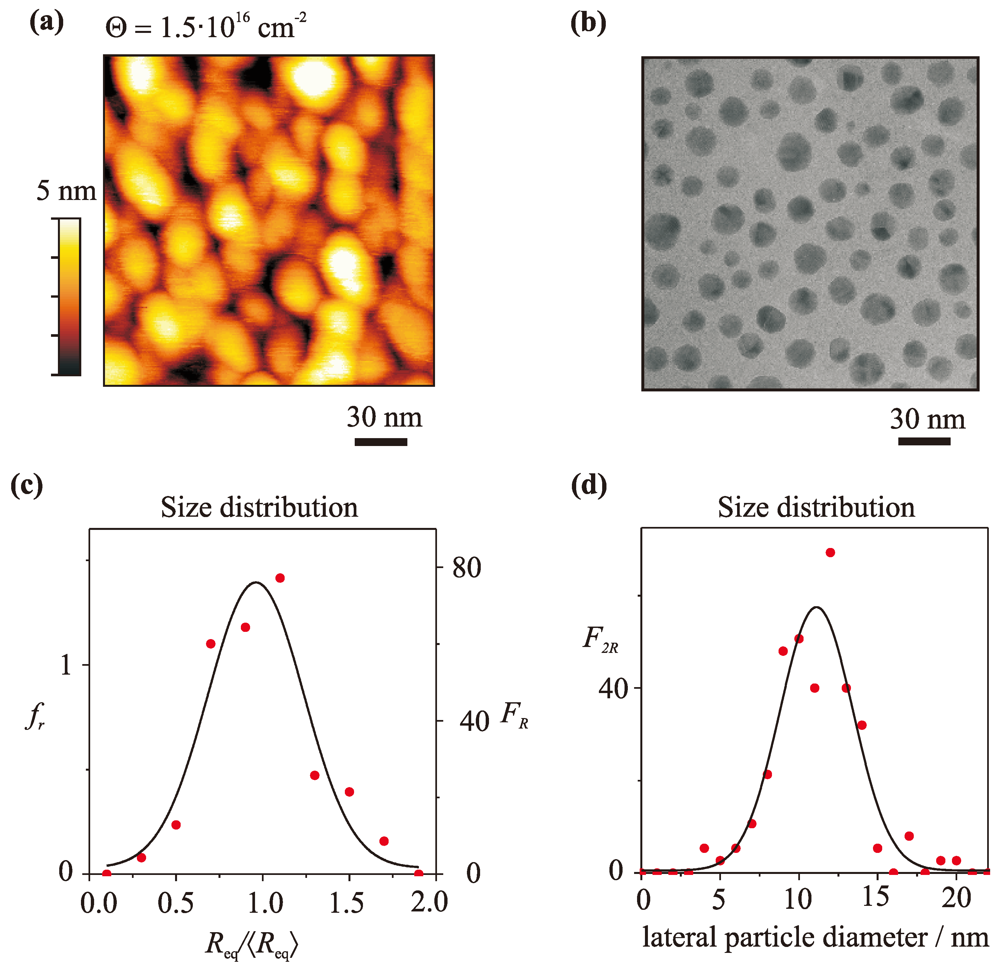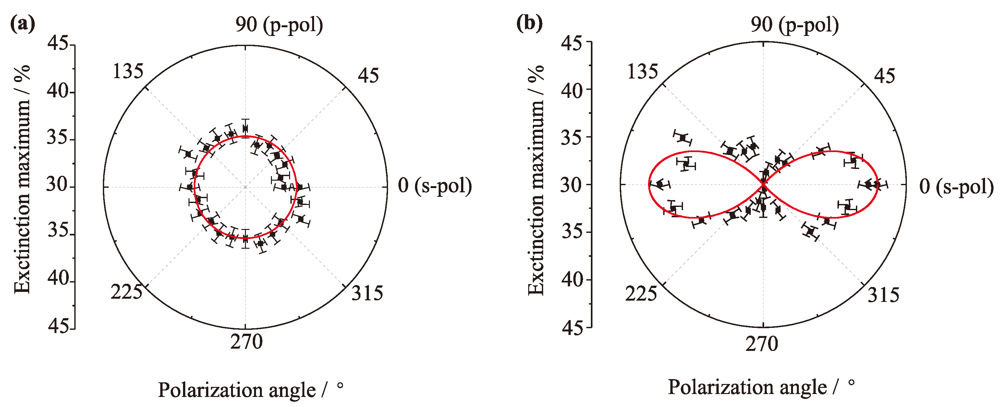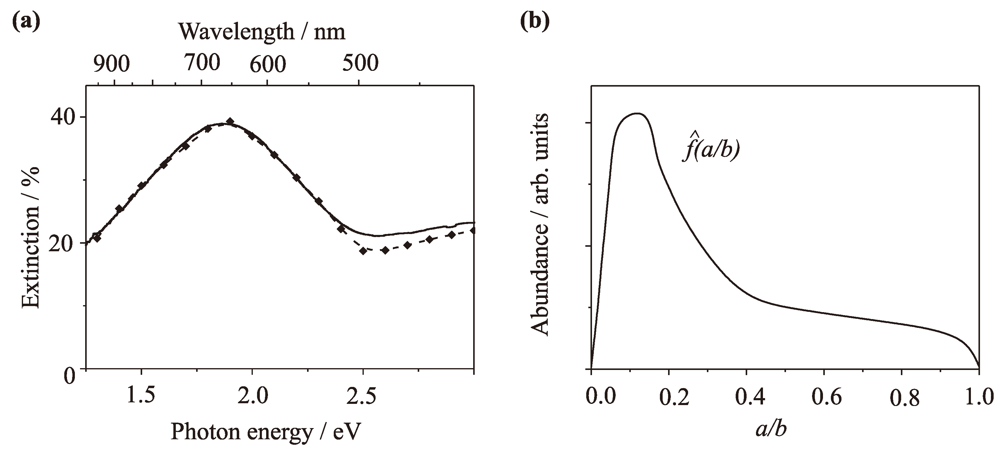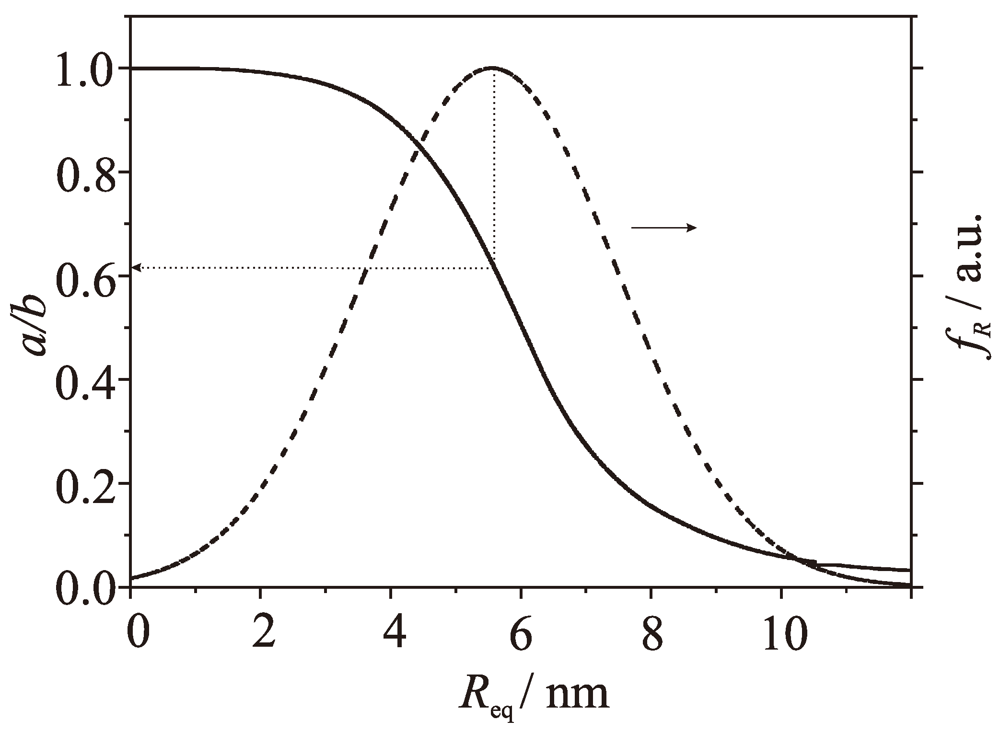Determination of Morphological Parameters of Supported Gold Nanoparticles: Comparison of AFM Combined with Optical Spectroscopy and Theoretical Modeling versus TEM
Abstract
:1. Introduction


- the asymmetric dielectric surrounding,
- the possibly broad size and shape distribution, and
- the particle-particle interaction within an ensemble.
2. Experimental
3. Results and Discussions
3.1. Determination of the Mean Particle Size and the Apparent Mean Shape

 of the nanoparticle ensemble. In addition to the measured spectrum, an absorption cross section in arbitrary units of a single gold nanoparticle with the same resonance frequency as the nanoparticle ensemble is depicted. Since the generated nanoparticles are well separated and exhibit radii smaller than R = 15 nm, the center frequency of its plasmon resonance depends only on the nanoparticle shape and the dielectric surrounding. Hence, performing a simple quasistatic modeling, taking the inhomogeneous environment into account by an effective dielectric constant [14,15], we obtain the apparent mean axial ratio of the nanoparticle ensemble, which amounts to
of the nanoparticle ensemble. In addition to the measured spectrum, an absorption cross section in arbitrary units of a single gold nanoparticle with the same resonance frequency as the nanoparticle ensemble is depicted. Since the generated nanoparticles are well separated and exhibit radii smaller than R = 15 nm, the center frequency of its plasmon resonance depends only on the nanoparticle shape and the dielectric surrounding. Hence, performing a simple quasistatic modeling, taking the inhomogeneous environment into account by an effective dielectric constant [14,15], we obtain the apparent mean axial ratio of the nanoparticle ensemble, which amounts to  = 0.14.
= 0.14.
3.2. Support Interaction
- First, the support changes the dielectric environment and, thus, shifts the plasmon resonance to longer wavelengths. This effect can be taken into account by including the Yamaguchi theory [46] in the quasistatic approximation, using a mixing factor m [15]. The mixing factor corresponds to the part of the nanoparticle surface in contact with the substrate and has a value between 0 and 1 [15]. For oblate nanoparticles on substrates m can be determined either from the energetic position of both plasmon modes [47] or due to a modeling of the nanoparticle geometry using the adhesion energy on the substrate and the surface energy of the metal [43,48]. The latter method is necessary for gold nanoparticles, because they exhibit only the (1,1)-mode. The Yamaguchi theory has been proven to be sufficient for most applications, although the dielectric environment is reduced to an average of the dielectric functions of the contributing environments [14,15].
- Second, due to the surface energies, an oblate growth is expected, which cause also a red-shift of the plasmon resonance. However, neither the TEM nor the AFM images yield a clear evidence of an oblate nanoparticle shape. Moreover, since for gold nanoparticles the (1,0)-mode is damped by the interband transition, also from the extinction spectrum the shape cannot be extracted directly.


3.3. Single Particle Characterization
 = 0.14 of the nanoparticle ensemble has been obtained. However, the apparent mean axial ratio corresponds to the shape of particles that have a dominant impact on the optical spectrum. Since the absorption cross section is proportional to R3 [15],
= 0.14 of the nanoparticle ensemble has been obtained. However, the apparent mean axial ratio corresponds to the shape of particles that have a dominant impact on the optical spectrum. Since the absorption cross section is proportional to R3 [15],  = 0.14 is not the most probable axial ratio in the nanoparticle distribution [23].
= 0.14 is not the most probable axial ratio in the nanoparticle distribution [23].- The particles are small compared to the wavelength of light, i.e., the electromagnetic field within the particles is spatially nearly constant [13,14]. A comparison between calculations performed with the quasistatic approximations and the T-matrix method for gold nanoparticles can be found in reference [15], Figure 2.11. The figure demonstrates that the quasistatic approximation is fairly sufficient for the nanoparticles with Req ≤ 15 nm.
- The optical properties of bulk materials ε(ω) without modifications due to quantum size effects can be used. This simplification is justified, because previous observations demonstrate that major disagreements may be anticipated for particles smaller than 1 nm [14]. Furthermore, the resonance condition is only slightly influenced by variations of ε(ω) due to the reduced dimensions for nanoparticles in our range of interest [52].
- Chemical interface damping (CID) is neglected. This assumption is justified, because for gold nanoparticles on sapphire, no CID has been observed [41]. On the other hand, for samples where CID is expected, it can be included in the theory by using an appropriate damping parameter in the size-dependent dielectric function [15].
- A strong correlation between the nanoparticle size and shape exists, which is fulfilled for nanoparticles grown in Volmer–Weber growth. Hence, the nanoparticle ensemble can be characterized by a functional dependence of the shape and size.
- Diploe-dipole interaction between the nanoparticles can be neglected. Note, particle-particle interaction might also cause a red shift of the plasmon resonance, but it has been demonstrated in a previous publication that a significant red-shift occurs only for very small distances between the particles [15]. The assumption is justified, because the broad shape distribution of the particles leads, in turn, to the broad distribution of plasmon frequencies, which reduces the mutual interaction between the particles. In other words, the adjacent particles are most probable of different shape and, hence, are not in resonance with each other.To demonstrate this, it is useful to treat the nanoparticles independently from their size. Thus, we define a dimensionless normalized distance d between the nanoparticles bywhere
the average distance between the nanoparticles that can be calculated from the particle number density measured by AFM. The functional dependence between d and the position of the plasmon resonance is displayed in Figure 4. The grey shaded area indicates the normalized distances of our nanoparticle ensembles for the coverages used in our experiments. Hence, the red-shift of the plasmon resonance due to a dipole-dipole interaction between the nanoparticles can be neglected for nanoparticles with ⟨Req⟩ = (5.5 ± 0.3) nm and a particle density of about np = 3 × 1011 particles/cm2, as investigated here.



 as
as  = fa/b(x)V (x) , which describes the axial ratio distribution and the impact of the particle volume on the spectrum, thus:
= fa/b(x)V (x) , which describes the axial ratio distribution and the impact of the particle volume on the spectrum, thus:

 , Equation (7) is fitted to the experimental data by a spline with about ten to twenty sampling points, and the mean error squares are minimized [60]. This procedure holds, since the spectral dependence of the plasmon resonance on the axial ratio follows a steady and monotonic function [13]. Figure 5(a) demonstrates that the modeled spectrum Sa/b ideally reproduces the experimental one. The function
, Equation (7) is fitted to the experimental data by a spline with about ten to twenty sampling points, and the mean error squares are minimized [60]. This procedure holds, since the spectral dependence of the plasmon resonance on the axial ratio follows a steady and monotonic function [13]. Figure 5(a) demonstrates that the modeled spectrum Sa/b ideally reproduces the experimental one. The function  , which has been extracted from the modeling, is depicted in Figure 5(b). It should be stressed here that the value of x = 0.14 at which
, which has been extracted from the modeling, is depicted in Figure 5(b). It should be stressed here that the value of x = 0.14 at which  peaks is the axial ratio previously denoted as apparent mean axial ratio
peaks is the axial ratio previously denoted as apparent mean axial ratio  It is neither the most probable axial ratio nor the mean axial ratio of the particle ensemble. Due to the convolution with the volume, the maximum of
It is neither the most probable axial ratio nor the mean axial ratio of the particle ensemble. Due to the convolution with the volume, the maximum of  peaks at lower values compared to fa/b(x) [23]. Nevertheless, the agreement to the simple modeling (cf. Section 3.1) is perfect.
peaks at lower values compared to fa/b(x) [23]. Nevertheless, the agreement to the simple modeling (cf. Section 3.1) is perfect. .
.
 .
.



| np / 1011 cm-2 | ⟨Req⟩ / nm | ⟨2b⟩ / nm | |
|---|---|---|---|
| TEM | 3.1 ± 0.3 | 12 ± 2 | |
| AFM | 2.9 ± 0.3 | 5.5 ± 0.3 | |
| Opt. Spec. + Modeling | 3.4 ± 0.3 | 5.5 ± 0.3 | 13 ± 2 |

4. Conclusions
Acknowledgements
References
- Valden, M.; Lai, X.; Goodman, D. Onset of catalytic activity of gold clusters on titania with the appearance of nonmetallic properties. Science 1998, 281, 1647–1650. [Google Scholar] [CrossRef]
- Chen, M.; Goodman, D. The structure of catalytically active gold on titania. Science 2004, 306, 252–255. [Google Scholar] [CrossRef]
- Zijlstra, P.; Chong, J.; Gu, M. Five-dimensional optical recording mediated by surface plasmons in gold nanorods. Nature 2009, 459, 410–413. [Google Scholar] [CrossRef]
- Krenn, J. Nanoparticle waveguides: Watching energy transfer. Nat. Mater. 2003, 2, 210–211. [Google Scholar] [CrossRef]
- Morarescu, R.; Englert, L.; Kolaric, B.; Damman, P.; Vallée, R.; Baumert, T.; Hubenthal, F.; Träger, F. Tuning nanopatterns on fused silica substrates: A theoretical and experimental approach. J. Mater. Chem. 2011, 21, 4076–4081. [Google Scholar]
- Hubenthal, F.; Blázquez Sánchez, D.; Borg, N.; Schmidt, H.; Kronfeldt, H.D.; Träger, F. Tailor-made metal nanoparticles as SERS substrates. Appl. Phys. B 2009, 95, 351–359. [Google Scholar] [CrossRef]
- Hubenthal, F.; Morarescu, R.; Englert, L.; Haag, L.; Baumert, T.; Träger, F. Parallel generation of nanochannels in fused silica with a single femtosecond laser pulse: Exploiting the optical near fields of triangular nanoparticles. Appl. Phys. Lett. 2009, 95, 063101-1–063101-3. [Google Scholar]
- Morarescu, R.; Englert, L.; Kolaric, B.; Damman, P.; Vallée, R.; Baumert, T.; Hubenthal, F.; Träger, F. Tuning nanopatterns on fused silica substrates: A theoretical and experimental approach. J. Mater. Chem. 2011, 21, 4076–4081. [Google Scholar]
- Ossig, R.; Kwon, Y.-H.; Hubenthal, F.; Kronfeldt, H.-D. Naturally grown Ag nanoparticles on quartz substrates as SERS substrate excited by a 488 nm diode laser system for SERDS. Appl. Phys. B 2012, 106, 835–839. [Google Scholar] [CrossRef]
- Morarescu, R.; Träger, F.; Hubenthal, F. Surface plasmon resonance spectroscopy for in situ sensing of molecular nanowire formation. In Recent Researches in Communications, Automation, Signal Processing, Nanotechnology, Astronomy and Nuclear Physics; Bojkovic, Z., Kacprzyk, J., Mastorakis, N., Mladenov, V., Revetria, R., Zadeh, L.A., Zemliak, A., Eds.; WSEAS Press: Cambridge, UK, 2011; pp. 308–313. [Google Scholar]
- Kwon, Y.-H.; Ossig, R.; Hubenthal, F.; Kronfeldt, H.-D. Influence of surface plasmon resonance wavelength on SERS activity of naturally grown silver nanoparticle ensemble. J. Raman Spec. 2012. [Google Scholar]
- Mie, G. Beiträge zur Optik trüber Medien, speziell kolloidaler Metallösungen. Annalen der Physik 1908, 25, 377–445. [Google Scholar] [CrossRef]
- Bohren, C.; Huffman, D. Absorption and Scattering of Light by Small Particles; Wiley: New York, NY, USA, 1983. [Google Scholar]
- Kreibig, U.; Vollmer, M. Optical Properties of Metal Clusters; Springer: Berlin, Germany, 1995. [Google Scholar]
- Hubenthal, F. Noble metal nanoparticles: Synthesis and applications. In Comprehensive Nanoscience and Technology; Andrews, D.L., Scholes, G.D., Wiederrecht, G.P., Eds.; Oxford Academic Press: New York, NY, USA, 2011; Volume 1, pp. 375–435. [Google Scholar]
- Gans, R. Über die F]orm ultramikroskopischer Goldteilchen. Ann. Physik 1912, 37, 881–900. [Google Scholar] [CrossRef]
- Hubenthal, F. Nanoparticles and their tailoring with laser light. Eur. J. Phys. 2009, 30, S49–S61. [Google Scholar] [CrossRef]
- Hubenthal, F.; Borg, N.; Weidner, T.; Siemeling, U.; Träger, F. Gold nanoparticle growth on self-assembled monolayers of ferrocenyl-substituted terpyridine on graphite. Appl. Phys. A 2009, 94, 11–17. [Google Scholar] [CrossRef]
- Hubenthal, F.; Borg, N.; Träger, F. Optical properties and ultrafast electron dynamics in gold-silver alloy and core-shell nanoparticles. Appl. Phys. B 2008, 93, 39–45. [Google Scholar] [CrossRef]
- Hilger, A.; Tenfelde, M.; Kreibig, U. Silver nanoparticles deposited on dielectric surfaces. Appl. Phys. B 2001, 73, 361–372. [Google Scholar] [CrossRef]
- Kreibig, U. Interface-induced dephasing of Mie plasmon polaritons. Appl. Phys. B 2008, 93, 79–89. [Google Scholar] [CrossRef]
- Morarescu, R.; Blázquez Sánchez, D.; Borg, N.; Vartanyan, T.; Träger, F.; Hubenthal, F. Shape tailoring of hexagonally ordered triangular gold nanoparticles with nanosecond-pulsed laser light. Appl. Surf. Sci. 2009, 225, 9822–9825. [Google Scholar]
- Hubenthal, F.; Hendrich, C.; Vartanyan, T.; Träger, F. Determination of fundamental morphological parameters of supported nanoparticle ensembles: Extracting the functional dependence between nanoparticle shape and size. Plasmonics 2012. [Google Scholar]
- Hicks, E.; Zou, S.; Schatz, G.; Spears, K.; van Duyne, R.; Gunnarsson, L.; Rindzevicius, T.; Kasemo, B.; Käll, M. Controlling plasmon line shapes through diffractive coupling in linear arrays of cylindrical nanoparticles fabricated by electron beam lithography. Nano Lett. 2005, 5, 1065–1070. [Google Scholar] [CrossRef]
- Wang, H.; Brandl, D.; Nordlander, P.; Halas, N.J. Plasmonic nanostructures: Artificial molecules. Acc. Chem. Res. 2007, 40, 53–62. [Google Scholar] [CrossRef]
- Hu, M.; Petrova, H.; Sekkinen, A.; Chen, J.; McLellan, J.; Li, Z.; Marquez, M.; Li, X.; Xia, Y; Hartland, G. Optical properties of Au-Ag nanoboxes studied by single nanoparticle spectroscopy. J. Phys. Chem. B 2006, 110, 19923–19928. [Google Scholar]
- Wu, W.; Dey, D.; Memis, O.; Katsnelson, A.; Mohseni, H. Fabrication of large area periodic nanustructures using nanosphere photolithograpy. Nanoscale Res. Lett. 2008, 3, 351–354. [Google Scholar] [CrossRef]
- Marty, R.; Arbouet, A.; Girard, C.; Margueritat, J.; Gonzalo, J.; Afonso, C. Sculpting nanometer-sized light landscape with plasmonic nanocolumns. J. Chem. Phys. 2009, 131, 224707:1–224707:8. [Google Scholar]
- Resta, V.; Siegel, J.; Bonse, J.; Gonzalo, J.; Afonso, C.; Piscopiello, E.; Van Tenedeloo, G. Sharpening the shape distribution of gold nanoparticles by laser irradiation. J. Appl. Phys. 2006, 100, 084311:1–084311:6. [Google Scholar]
- Gonzalo, J.; Perea, A.; Babonneau, D.; Afonso, C.; Beer, N.; Barnes, J.P.; Petford-Long, A.; Hole, D.; Townsend, P. Competing processes during the production of metal nanoparticles by pulsed laser deposition. Phys. Rev. B 2005, 71, 125420-1–125420-8. [Google Scholar]
- Barnes, J.P.; Petford-Long, A.; Doole, R.; Serna, R.; Gonzalo, J.; Suárez-García, A.; Afonso, C.; Hole, D. Structural studies of Ag nanocrystals embedded in amorphous Al2O3 grown by pulsed laser deposition. Nanotechnology 2002, 13, 465–470. [Google Scholar] [CrossRef]
- Novo, C.; Gomez, D.; Perez-Juste, J.; Zhang, Z.; Petrova, H.; Reismann, M.; Mulvaney, P.; Hartland, G. Contributions from radiation damping and surface scattering to the linewidth of the longitudinal plasmon band of gold nanorods: a single particle study. Phys. Chem. Chem. Phys. 2006, 8, 3540–3546. [Google Scholar]
- Pyatenko, A.; Shimokawa, K.; Yamaguchi, M.; Nishimura, O.; Suzuki, M. Synthesis of silver nanoparticles by laser ablation in pure water. Appl. Phys. A 2004, 79, 803–806. [Google Scholar]
- Dadosh, T.; Sperling, J.; Bryant, G.; Breslow, R.; Shegai, T.; Dyshel, M.; Haran, G.; Bar-Joseph, I. Plasmonic control of the shape of the raman spectrum of a single molecule in a silver nanoparticle dimer. ACS Nano 2009, 3, 1988–1994. [Google Scholar]
- Pastoriza-Santos, I.; Liz-Marzán, L. Colloidal silver nanoplates. State of the art and future challenges. J. Mater. Chem. 2008, 18, 1724–1737. [Google Scholar] [CrossRef]
- Stalmashonak, A.; Seifert, G.; Graener, H. Optical three-dimensional shape analysis of metallic nanoparticles after laser-induced deformation. Optics Lett. 2007, 32, 3215–3217. [Google Scholar] [CrossRef]
- Vogel, F.; Träger, F.; Hubenthal, F. A new route for mass production of uniform metal nanoparticles in water by means of laser light induced processes. J. Nanosci. Nanotechnol. 2011, 11, 2368–2375. [Google Scholar]
- Watanabe, K.; Menzel, D.; Nilius, N.; Freund, H.J. Photochemistry on metal nanoparticles. Chem. Rev. 2006, 106, 4301–4320. [Google Scholar] [CrossRef]
- MacDonald, K.; Fedotov, V.; Zheludev, N. Optical nonlinearity resulting from a light-induced structural transition in gallium nanoparticles. Appl. Phys. Lett. 2003, 82, 1087–1089. [Google Scholar] [CrossRef]
- Hubenthal, F. Ultrafast dephasing time of localized surface plasmon polariton resonance and the involved damping mechanisms in colloidal gold nanoparticles. Prog. Surf. Sci. 2007, 82, 378–387. [Google Scholar] [CrossRef]
- Hubenthal, F.; Hendrich, C.; Träger, F. Damping of the localized surface plasmon polariton resonance of gold nanoparticles. Appl. Phys. B 2010, 100, 225–230. [Google Scholar] [CrossRef]
- Ouacha, H.; Hendrich, C.; Hubenthal, F.; Träger, F. Laser-assisted growth of gold nanoparticles: Shaping and optical characterization. Appl. Phys. B 2005, 81, 663–668. [Google Scholar] [CrossRef]
- Campbell, C. Ultrathin metal films and particles on oxide surfaces: structural, electronic and chemisorptive properties. Surf. Sci. Rep. 1997, 27, 1–111. [Google Scholar] [CrossRef]
- Stietz, F. Lasermanipulation of the size and shape of supported nanoparticles. Appl. Phys. A 2001, 72, 381–394. [Google Scholar] [CrossRef]
- Grabar, K.; Brown, K.; Keating, C.; Stranick, S. Nanoscale characterization of gold colloidmonolayers: a comparison of four techniques. Anal. Chem. 1997, 69, 471–477. [Google Scholar] [CrossRef]
- Yamaguchi, T.; Yoshida, S.; Kinbara, A. Optical effect of the substrate on the anomalous absorption of aggregated silver films. Thin Solid Films 1974, 21, 173–187. [Google Scholar] [CrossRef]
- Hendrich, C. Untersuchung der Elektronendynamik in Goldnanoteilchen durch Messung der Dephasierungszeit des Oberflächenplasmons mit spektralem Lochbrennen.
- Ziegler, T. Dephasierungszeit des Oberflächenplasmon-Polaritons: Spektrales Lochbrennen an Edelmetall-Nanoteilchen.
- Wenzel, T.; Bosbach, J.; Stietz, F.; Träger, F. In situ determination of the shape of supported metal clusters during growth. Surf. Sci. 1999, 432, 257–264. [Google Scholar] [CrossRef]
- Xu, G.; Tazawa, M.; Jin, P.; Nakao, S. Surface plasmon resonance of sputtered Ag films: substrate and mass thickness dependence. Appl. Phys. A 2005, 80, 1535–1540. [Google Scholar] [CrossRef]
- Bouwen, W.; Kunnen, E.; Temst, K.; Thoen, P.; van Bael, M.; Vanhoutte, F.; Weidele, H.; Lievens, P.; Silverans, R. Characterization of granular Ag films grown by low-energy cluster beam deposition. Thin Solid Films 1999, 354, 87–92. [Google Scholar] [CrossRef]
- Hövel, H.; Becker, T.; Bettac, A.; Reihl, R.; Tschudy, M.; Williams, E. Controlled cluster condensation into preformed nanometer-sized pits. J. Appl. Phys. 1997, 81, 154-1–154-5. [Google Scholar] [CrossRef]
- Maxwell-Garnett, J. Colours in metal glasses and in metallic films. Philos. Trans. Roy. Soc. 1904, 203, 385–420. [Google Scholar] [CrossRef]
- Maxwell-Garnett, J. Colours in metal glasses, in metallic films, and in metallic solution. II. Philos. Trans. Roy. Soc. 1906, 205, 237–288. [Google Scholar] [CrossRef]
- Lichtenecker, K. Die Dielektrizitätskonstante natürlicher und künstlicher MischkÖrper. Physik Z 1926, 27, 115–158. [Google Scholar]
- Sihvola, A. Electromagnetic Mixing Formulas and Applications; IEE Press: Stevenage, UK, 1999. [Google Scholar]
- Landau, L.; Lifschitz, E. Lehrbuch der theoretischen Physik VIII; Akademie Verlag: Berlin, Germany, 1974. [Google Scholar]
- Beer, A. Einleitung in die höhere Optik; Vieweg: Braunschweig, Germany, 1853. [Google Scholar]
- Li, X.; Tamada, K.; Baba, A.; Knoll, W.; Hara, M. Estimation of dielectric function of biotin-capped gold nanoparticles via signal enhancement on surface plasmon resonance. J. Chem. Phys. B 2006, 110, 15755–15762. [Google Scholar] [CrossRef]
- Press, W.; Teukolsky, S.; Vetterling, W.; Flannery, B. Numerical Recipes in C, 2nd ed; Cambridge University Press: New York, NY, USA, 1992. [Google Scholar]
© 2012 by the authors; licensee MDPI, Basel, Switzerland. This article is an open-access article distributed under the terms and conditions of the Creative Commons Attribution license (http://creativecommons.org/licenses/by/3.0/).
Share and Cite
Hubenthal, F.; Blázquez Sánchez, D.; Träger, F. Determination of Morphological Parameters of Supported Gold Nanoparticles: Comparison of AFM Combined with Optical Spectroscopy and Theoretical Modeling versus TEM. Appl. Sci. 2012, 2, 566-583. https://doi.org/10.3390/app2030566
Hubenthal F, Blázquez Sánchez D, Träger F. Determination of Morphological Parameters of Supported Gold Nanoparticles: Comparison of AFM Combined with Optical Spectroscopy and Theoretical Modeling versus TEM. Applied Sciences. 2012; 2(3):566-583. https://doi.org/10.3390/app2030566
Chicago/Turabian StyleHubenthal, Frank, David Blázquez Sánchez, and Frank Träger. 2012. "Determination of Morphological Parameters of Supported Gold Nanoparticles: Comparison of AFM Combined with Optical Spectroscopy and Theoretical Modeling versus TEM" Applied Sciences 2, no. 3: 566-583. https://doi.org/10.3390/app2030566






